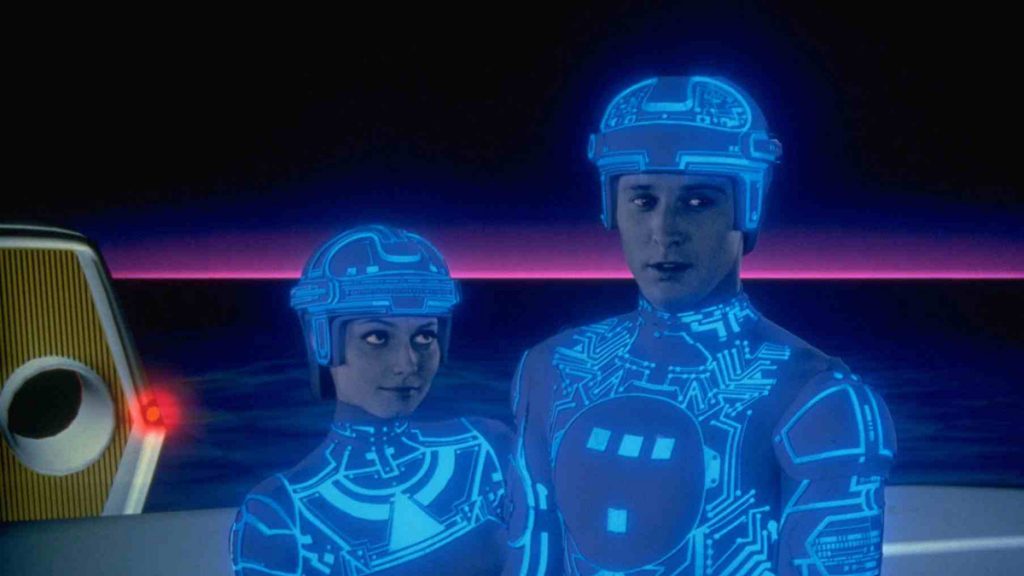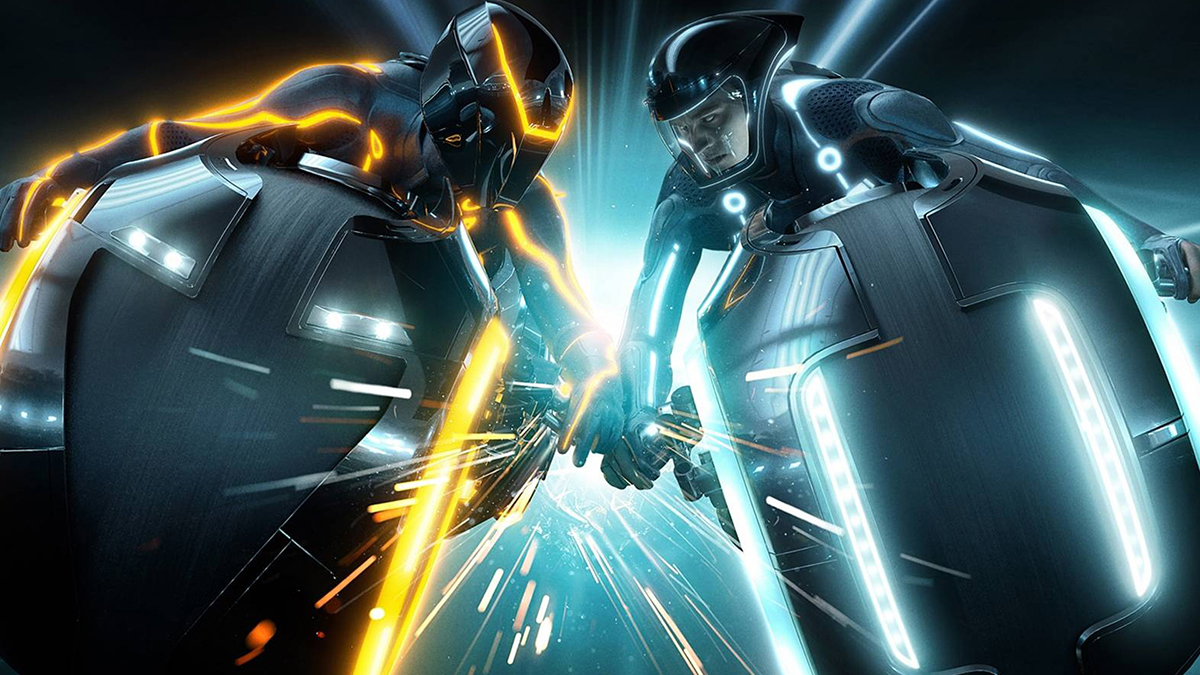Core Data:
- Vision: Tron’s virtual world
- Type: Popular culture – Film
- As Seen In: Tron, Tron: Legacy, Tron: Uprising
- Envisioned: 1982, 2010
- Visionaries: Steven Lisberger, Joseph Kosinski (directors)
- Target Date: Most of the developments should have already happened, between 1982 and 1990
Overview:
From state-of-the-art visual effects in blockbuster movies to Pixar’s succession of animated classics, computer-generated imagery has become one of the most important tools in a filmmaker’s arsenal. Back in 1982, however, CG was still in its infancy, meaning that when Disney took groundbreaking steps into the digital realm with Tron, it was showing audiences things they’d never seen before.
As soon as Jeff Bridges’ Kevin Flynn was sucked into the neon-drenched world inside a computer, we were transported to a vast metaverse packed with ruthless killing machines, gladiatorial battles to the death, and super-fast light cycle races. This was arguably an overly literal use of the nascent technology – computer effects = computer setting – but the movie remains a pivotal moment in the development of CG on screen.
And while the idea of vast mainframes populated by tiny human-like avatars makes very little sense in the real world, the world created by director Steven Lisberger does at least have its own consistent internal logic – a clever visualisation of the inner-workings of a machine.
The potential of this virtual space was explored further when director Joseph Kosinski returned to the Grid nearly three decades later with the stylish Tron: Legacy – and this time he brought Daft Punk along to provide some killer tunes.

Key Tenets:
- Company: Working for early ’80s tech giant ENCOM, programmers Walter Gibbs and Ed Dillinger created Tron’s computer mainframe – subsequently controlled by the power-hungry Master Control Program (MCP).
- The complex digital world later seen in sequel Tron: Legacy was created by software developer/arcade owner Kevin Flynn (by this point the CEO of ENCOM) as a side project away from the main business.
- IP: Although it failed to credit Flynn for creating many of its most popular arcade games, ENCOM owned many hit franchises, including Light Cycles, Matrix Blaster, Space Paranoids and Astro-Gunner.
- A Tron arcade machine also makes an appearance in Tron: Legacy, hiding the entrance to Flynn’s secret research lab.
- Experience: Kevin Flynn and – years later – his son, Sam, are digitised, and find their entire consciousnesses transported into a vast computer mainframe.
- Kevin was first transported into the digital space by the MCP, who wanted to stop him snooping around the mainframe.
- The computer world’s design aesthetic would most accurately be described as “neon chic”.
- In the original Tron (set in the early ’80s), ENCOM’s sophisticated mainframe (or “Grid”) is ruled over by a malevolent AI known as the Master Control Program (or MCP) – a learning machine that’s over 2,000 times smarter than when it was first created.
- As well as managing company systems, the MCP has designs on infiltrating the Pentagon and the Kremlin.
- All of the systems inside the ENCOM mainframe are operated by autonomous humanoid avatars. These avatars take on the appearance of their human ‘Users’ in the outside world.
- Security programs such as the eponymous Tron protect the avatars from the MCP and its stooges.
- Avatars participate in gladiatorial arcade-style games, including light cycle racing and a pelota-like ball game.
- Most games have a survival element, where failure leads to avatars being ‘derezzed’ – a nice way of saying obliterated from existence.
- Avatars carry identity discs, which contain a record of everything you do or learn on the Grid. If they lose it or fail to follow commands, they’re subject to ‘deresolution’.
- Given the importance of these discs, it seems ill-judged that avatars use them as weapons, throwing them at each other like super-charged frisbees.
- Over the subsequent decade, Kevin Flynn set out to build a perfect computer world. He was accidentally trapped inside his creation for two decades, until his son, Sam, was inadvertently lured into the Grid.
- Once Flynn’s new system had come online, it spontaneously generated new lifeforms known as Isomorphic Algorithms (or Isos).
- Like the original ENCOM mainframe, Flynn’s brave new world is susceptible to malevolent new management – this time in the form of Flynn’s long-serving avatar, Clu. Recruited to manage the Grid in Flynn’s absence, Clu’s vision of “perfection” leads to a dictatorship – and a purge of all of the Isos.
- You can only leave Flynn’s incarnation of the Grid by means of a portal. The fatal flaw for human users is that it remains open for a limited amount of time and can only be opened from outside – consequently, there is a high risk of being trapped in the digital realm.
- On the other hand, this is a sensible failsafe to prevent rogue AIs like Clu escaping into the real world, and continuing their misguided quest for perception.
- At the end of Tron: Legacy we learn that digital constructs can be given form in the real world, when Flynn’s sidekick Quorra (herself an undercover Iso) makes the trip with Sam.
- Hardware: ENCOM’s internal systems in Tron are powered by a powerful in-house computer that uses the MCP as its operating system.
- The internal architecture inside arcade machines is also based on the human-like avatar system seen inside the ENCOM mainframe.
- Kevin Flynn’s later incarnation is operated via a standard computer space. Where he keeps the servers to store all this complex information is not revealed.
- The SHV 20905 laser (known as Shiva) is used to digitise a human being, and convert them into computer code. It’s a new iteration of a device created by ENCOM employees Walter Gibbs and Lora Baines.
- The equipment can also be used to turn digital avatars into solid matter in the real world.
- Economics: ENCOM started off in a garage in 1972. Ten years later it was working in 30 different countries, and moving beyond games to work on defence contracts. In other words, ambitious (if slightly evil) CEO Ed Dillinger had a licence to print money.
State of Play (November 2021)
- Experience: Having your entire being transported into a computer system via a laser beam is not currently possible. In fact, the process seems to defy so many laws of physics that it’s more akin to magic than science. While energy and matter are interchangeable (as explained via Albert Einstein’s well known E=mc2 equation), one 80kg human being would generate a whopping 7,000,000,000,000 megajoules of energy – that’s more than you’d get from thousands of nuclear explosions, so it wouldn’t just burn a hole in a computer circuit…
- There’d be similar issues if you wanted to go the other way and turn computer code into physical form: where would the vast quantities of energy come from? And how would you transfer all the zeroes and ones that represent the avatar’s thought processes into an organic body?
- Unless scientists are very much mistaken about how electrons move around microchips, the inner workings of a computer don’t involve humanoid avatars interacting with one another. (If this did turn out to be the case, it would be time to rewrite quantum theory…)
- Artificial intelligence is becoming more and more part of our lives, but not quite in the ‘thinking computer’ vein of the MCP. Even the most sophisticated present-day AI uses its programming to anticipate its next move, rather than utilising genuine thought processes or free will. If you’ve ever watched The Terminator or The Matrix, this is arguably a good thing.
- There is no evidence that life can be spontaneously generated inside a computer. That said, life on Earth seems to have resulted from the culmination of a very particular set of conditions. It’s highly improbable, of course, but who’s to say that a digital equivalent of primordial soup might not be possible?
- Hardware: AI is now so commonplace in our homes – from Siri to Alexa to Cortana and beyond – that we regularly talk to machines. It’s important to remember, however, that their responses are pre-programmed – they’re not really our friends.
- AI is also used in games to make NPCs (non-player characters) more life-like.
- Economics: It’s unlikely that anyone would ever invest in computer technology powered by hundreds of little people – it seems much less efficient than circuit boards, and rather more prone to insurrection.
- Large corporations often employ sophisticated computer systems to manage their day-to-day business. Thankfully, however, they’re not usually as ruthlessly efficient (or evil) as the MCP.
- Company and IP: Tron and its spin-offs are owned by the Walt Disney Company – a business which has had great success maximising the money-making potential of its brands.
Reality check: Not likely
Both Tron movies are memorable for their groundbreaking visuals, but their stories don’t stand up to quite so much scrutiny. The idea of an entire human being digitised into computer code, their thoughts and physical form being translated into zeroes and ones, is preposterous on every level, and unlikely to be replicated any time soon – if ever.
Tron’s portrayal of artificial intelligence is probably closer to the truth, but we’re still some way away from ambitious machines that can think for themselves – and we should all be thankful for that…
Further reference
- Tron (film)
- Tron: Legacy (film)
- Tron: Uprising (TV show)
- Artificial intelligence
A self-confessed full-time geek, freelance journalist Richard has spent most of his career writing about sci-fi and fantasy – including more than a decade on staff for SFX magazine. He's particularly keen on franchises with "Star" in the title.






































